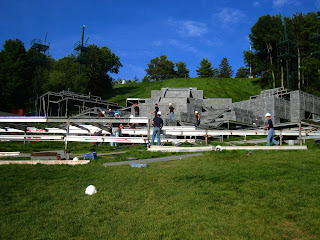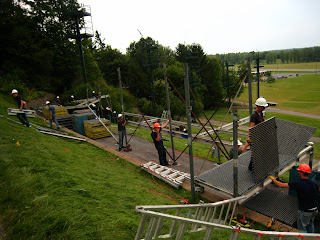Before I get into the specifics of how the stage transformed from a blank hill to this:

I just want to give a brief rundown of what this work crew experience consisted of and roughly what we did during our month in Palmyra. The work crew consists of 26 young men ages 17-19 (67 boys applied this year). The work crew experience is meant to provide good preparation for our missions. We arrive a week before the 700-some-odd cast members and spend the first 5ish days building the stage from scratch. The cast arrives at this point and the work crew becomes the tech crew for the show. 14 of us work on the ground crew while the other 12 work on the light crew. I'll go into details of each crew in a later blog post. For the next week, we rehearse our parts with the cast as they rehearse their acting as well. The next week is performance week. After performances end, the cast and most of the staff leave, leaving the work crew to strike the stage. We do this in about 2 days, leaving a few more days to do last-minute playing around and sight-seeing.
This is an extremely rough rundown of what goes on. There are plenty of activities we participate in in between our work crew duties, which will be laid out in better detail in (you guessed it) another blog post.
But anyways, onto the construction! The stage is layed out as follows:


I just want to give a brief rundown of what this work crew experience consisted of and roughly what we did during our month in Palmyra. The work crew consists of 26 young men ages 17-19 (67 boys applied this year). The work crew experience is meant to provide good preparation for our missions. We arrive a week before the 700-some-odd cast members and spend the first 5ish days building the stage from scratch. The cast arrives at this point and the work crew becomes the tech crew for the show. 14 of us work on the ground crew while the other 12 work on the light crew. I'll go into details of each crew in a later blog post. For the next week, we rehearse our parts with the cast as they rehearse their acting as well. The next week is performance week. After performances end, the cast and most of the staff leave, leaving the work crew to strike the stage. We do this in about 2 days, leaving a few more days to do last-minute playing around and sight-seeing.
This is an extremely rough rundown of what goes on. There are plenty of activities we participate in in between our work crew duties, which will be laid out in better detail in (you guessed it) another blog post.
But anyways, onto the construction! The stage is layed out as follows:

By the way, now that you've seen the diagram, I get liberty to name the stages and assume you know where it is ;)
We arrived at the hill and found palettes that looked like this:
Fortunately the stage pieces have been labeled sufficiently that the construction of it becomes a fun little puzzle for us. If you zoom in on the following picture, you'll notice little yellow numbers on the beams and posts. The posts are placed into premade holes (or set on pads on the asphault pathways). The beams either fit into little holders on the posts or bolted into other beams.
We arrived at the hill and found palettes that looked like this:

Fortunately the stage pieces have been labeled sufficiently that the construction of it becomes a fun little puzzle for us. If you zoom in on the following picture, you'll notice little yellow numbers on the beams and posts. The posts are placed into premade holes (or set on pads on the asphault pathways). The beams either fit into little holders on the posts or bolted into other beams.

After all of the posts and beams are in (and tightened down), we place the fibergrating. This is fiberglass grating that made walking on the stages possible! You can see it on palettes in the previous 2 pictures and in place in the following one.

After screwing in all the little fibergrating clamps, we place all of the staircases. The forklift places them nearby where they belong and we lift each one into place, except for the 3 larger staircases that connect stages 7 and 3:


After the stairs are in place, we throw down the rubber matting (the red stuff 3 pictures back) and zip-tie it to the fibergrating. This is to help protect the actors from the splintery and harder fibergrating.
During all of our construction, a couple staff members in charge of safety lighting install the lighting in. The end result is cool looking and extremely helpful during performances:

That's pretty much all there is to the construction of the stage. Our schedule required us to be building for 10+ hours on an average day, waking up at 6:30 and getting to bed by 10:30. I was very sleep deprived by the end of the experience by the end of all of this, but it was so worth it!
Here's a view during performances:

That's pretty much all there is to the construction of the stage. Our schedule required us to be building for 10+ hours on an average day, waking up at 6:30 and getting to bed by 10:30. I was very sleep deprived by the end of the experience by the end of all of this, but it was so worth it!
Here's a view during performances:





No comments:
Post a Comment